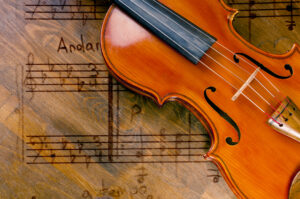 Scales studies are fundamental for any instrument. Our Houston violin lessons include this important aspect of violin playing. Scales teach geography, where notes are on the instrument, intonation, bow control, shifting, and many other techniques of violin playing. There are many different scale methodologies teachers use, depending on the level of the student and goals of scale practice. However, there are a few main systems that are used, especially at the intermediate and advanced level. Each system covers similar aspects to scale playing but with a unique focus.
Scales studies are fundamental for any instrument. Our Houston violin lessons include this important aspect of violin playing. Scales teach geography, where notes are on the instrument, intonation, bow control, shifting, and many other techniques of violin playing. There are many different scale methodologies teachers use, depending on the level of the student and goals of scale practice. However, there are a few main systems that are used, especially at the intermediate and advanced level. Each system covers similar aspects to scale playing but with a unique focus.
Beginning Scales
Before diving into the scale systems, most Houston violin teachers start off with basic scales, either using scale sheets that can be found on multiple websites or by writing the scales out for their students. The first few scales students learn are one or two octaves in first position, focusing on intonation and bow control. Basic arpeggios are sometimes also included in early scale practice. This also works to teach intonation, note reading, and hand frame. Some common beginner scale books include Scales in First Position for Violin and Essential Scales and Studies for Violin.
Hirmaly Scale Studies
The Hirmaly Scale Studies is a good step between beginning and intermediate scales. This book starts out with one and two octave scales and uses different rhythms and dynamics to further focus on bow control. Then, the book works through scales in different positions, working on fingerboard geography. The middle portions of this scale system works on different scale patterns, moving through different positions and keys. The final portion of the book introduces three octave scales. The Hirmaly scales is perfect to introduce shifting and different keys, both major and minor. It is a good choice when preparing for the more complex scale systems, like the. Flesch and Galamian systems.
Sitt Scale Studies for Violin
The Sitt Scale Studies for Violin is very similar to the Hirmaly scale system. The book starts with two octave scales and then progresses to three octave scales and scales in thirds. This book differs from Hirmaly in that Sitt includes a section on chromatic scales, but it does not have as many finger patterns as the Hirmaly system. This book can be used interchangeably or in addition to the Hirmaly system to focus more on finger patterns and chromatic scales.
Flesch Scale System
The Flesch Scale System is one of the most used scale systems, especially for intermediate and advanced students. This book is organized by key, rather than by type of scale. Each key includes one octave scales and arpeggio sequence on each string, three octave scales and arpeggios, and scales using double stops. The arpeggio sequence and double stop scales set this scale system apart from the others. The arpeggios further develop fingerboard geography and intonation, and the scales themselves continue to develop intonation and shifting. The double stop scales, including thirds, sixths, and octaves, work to build the hand frame and improve intonation and left-hand flexibility. This system is perfect for more advanced students. It can be overwhelming to start at first, but the skills this system teaches will make mastering concertos and more complex repertoire much easier.
Galamian Contemporary Violin Technique
Galamian’s Contemporary Violin Technique is a two-volume collection similar to the Flesch system. Either Galamian or Flesch scales can be used at the advanced level of scale study. In the first volume, Galamian scales focus more on rhythm and bowing patterns, whereas Flesch scales include more double stops. The Galamian system begins with scales in one position and with one finger, working on shifting and fingerboard geography. The scales also include an acceleration sequence, working on speed and accuracy. The book continues to three and four octave scales, with an arpeggio sequence similar to the Flesch system. The rest of the book focuses on scale variations, such as broken thirds or scales on one string. The back of the book contains a list of different rhythms and bowings that can be used with the scales. The rhythms and bowings will improve bow control, intonation, and greater left-hand accuracy. The second volume in this system focuses on double stops, similar to the double stops found in Flesch.
For more information about violin lessons, contact us today. Our staff will be able to help set you up with our violin instructors. They can either come to your home to teach or can also provide online music lessons. Our virtual music lessons are taught by local music teachers who plan their lessons to suit your child.
by Abigail Bracewell
